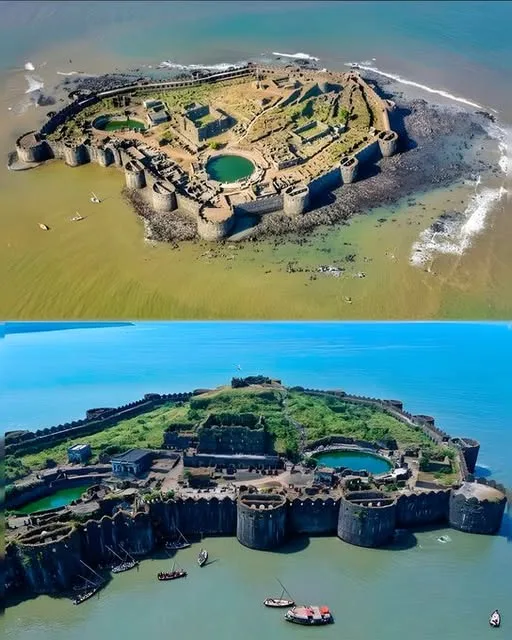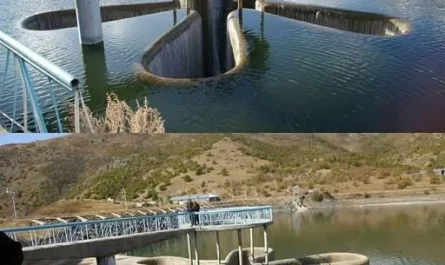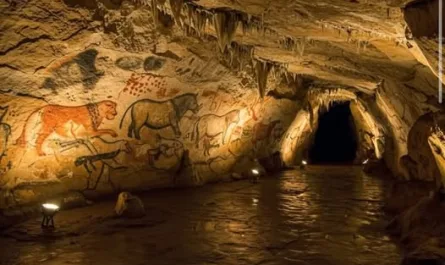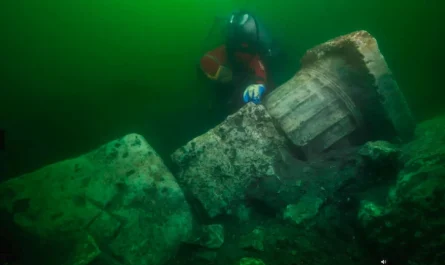Rising defiantly from the waves of the Arabian Sea, Janjira Fort stands as a testament to architectural ingenuity and unyielding resilience. Located off the coast of Murud in Maharashtra, India, this 16th-century maritime fortress is renowned as the “undefeated fort,” having withstood relentless assaults by the British, Portuguese, and Marathas, none of whom could breach its formidable defenses. Surrounded by saltwater on all sides, Janjira’s strategic design—complete with rumored secret underwater passages and a mysterious freshwater lake—made it an impregnable stronghold. This blog post delves into the history, engineering marvels, and enduring mysteries of Janjira Fort, a jewel of Indian maritime heritage that continues to captivate historians, adventurers, and travelers alike.

A Fortress Born of Strategy and Ambition
Janjira Fort, also known as Murud-Janjira, was constructed in the late 15th to early 16th century under the Siddi rulers, a community of African descent who rose to power along India’s Konkan coast. Originally a wooden fort built by local fishermen, it was transformed into a stone stronghold by the Siddis, likely under the patronage of the Nizamshahi dynasty of Ahmadnagar. By the 1560s, the fort was fully fortified under Siddi chieftain Malik Ambar, a brilliant military strategist who leveraged its island location to establish a naval powerhouse.
Perched on an oval-shaped rocky outcrop 2 kilometers offshore from Murud, Janjira spans approximately 22 acres and is encircled by towering walls, some reaching 40 feet high and 10 feet thick. Its strategic position in the Arabian Sea made it a linchpin for controlling maritime trade routes along the Konkan coast, a vital artery for commerce during the medieval period. The fort’s name, derived from the Arabic word jazeera (meaning “island”), reflects its isolated, sea-bound existence, which was key to its invincibility.
Janjira withstood numerous sieges, including attacks by the Portuguese in the 16th and 17th centuries, the Marathas under Shivaji and his successors, and later the British East India Company. Its robust defenses—19 rounded bastions, each armed with cannons, and walls designed to absorb cannon fire—thwarted every assault. The fort’s isolation, accessible only by boat, further deterred invaders, as did the Siddis’ naval prowess, which allowed them to repel attacks and maintain supply lines.
The Enigma of Secret Passages
One of Janjira’s most intriguing features is the legend of its secret underwater passages. According to local lore, hidden tunnels connected the fort to nearby mainland villages, such as Murud or Rajpuri, providing covert escape routes and supply channels during sieges. These passages were said to run beneath the Arabian Sea, an engineering feat that, if true, would be extraordinary for its time. The tunnels allegedly allowed the Siddis to ferry provisions, reinforcements, or even spies without detection, confounding enemies who blockaded the fort.
While no definitive evidence confirms the existence of these underwater passages, their legend persists, blending historical possibility with myth. Some historians speculate that natural caves or man-made tunnels within the rocky outcrop could have served as storage or escape routes, though tidal fluctuations and the fort’s age make exploration challenging. Modern visitors report seeing submerged openings near the fort’s base, fueling speculation, but archaeological surveys have yet to uncover concrete proof. Whether fact or folklore, these rumored passages enhance Janjira’s mystique, painting it as a fortress of secrets as much as stone.
The Miracle of the Freshwater Lake
Perhaps the most remarkable feature of Janjira Fort is its freshwater lake, an anomaly amidst the saltwater of the Arabian Sea. Known as the “Sweet Water Lake,” this natural reservoir provided a critical lifeline during prolonged sieges, enabling the fort’s inhabitants to endure without relying on external supplies. The lake’s existence is a geological marvel, likely formed by an underground spring or aquifer within the rocky island, defying the surrounding saline environment.
The freshwater lake, nestled within the fort’s walls, was a strategic masterstroke. It ensured self-sufficiency, allowing the Siddis to withstand months-long blockades without surrendering to thirst or scarcity. Visitors today can still see the remnants of this lake, its calm waters a stark contrast to the turbulent sea beyond. The lake’s presence not only highlights the fort’s ingenious design but also underscores the Siddis’ ability to harness natural resources to fortify their stronghold.
Architectural and Defensive Brilliance
Janjira’s design is a masterclass in defensive architecture. Its walls, built from local basalt stone, were constructed to withstand cannon fire, with rounded bastions that minimized damage from artillery. The fort’s 19 bastions, named after strategic or symbolic elements (e.g., Darya Burj or “Sea Tower”), housed massive cannons, some still visible today, including the formidable Kalal Bangdi, a cannon said to have a range of over 12 kilometers. The main entrance, accessible only by boat and flanked by intricate carvings of lions and elephants, was designed to intimidate and deter.
The fort’s interior included palaces, mosques, granaries, and quarters for soldiers, all arranged to maximize functionality during sieges. Its high walls and strategic vantage points offered unobstructed views of the sea, allowing defenders to spot approaching fleets from miles away. The Siddis’ naval expertise complemented the fort’s design, with their fleet of small, agile ships outmaneuvering larger European vessels. This combination of architecture, strategy, and naval power made Janjira an unconquerable fortress for centuries.
A Cultural and Historical Legacy
Janjira Fort’s history is inseparable from the Siddis, a community of African origin who arrived in India as traders, mercenaries, or enslaved individuals during the medieval period. Under leaders like Malik Ambar, the Siddis carved out a semi-independent state, ruling Janjira until 1948, when it was integrated into the Indian Union. Their legacy as skilled navigators and warriors endures, with Janjira standing as a monument to their resilience and ingenuity.
The fort’s cultural significance extends beyond its military history. It represents a unique blend of African, Indian, and Islamic influences, evident in its architecture and the stories of its rulers. The Siddis’ ability to maintain autonomy against powerful adversaries like the Marathas and Europeans highlights their diplomatic and military acumen. Today, the fort is a popular tourist destination, drawing visitors eager to explore its crumbling yet majestic walls, cannons, and the enigmatic freshwater lake.
Visiting Janjira Fort Today
Located about 165 kilometers south of Mumbai, Janjira Fort is accessible via a scenic ferry ride from Murud’s Rajpuri jetty, a 10–15 minute journey across the Arabian Sea. The fort is open to visitors daily from 7 AM to 6 PM, with no entry fee, though the ferry costs approximately ₹50–100 round-trip (as of 2025). The best time to visit is between October and March, when the weather is cooler and less humid. Visitors should wear sturdy shoes for navigating the fort’s uneven stone paths and bring water, as facilities within are limited.
The fort is maintained by the Archaeological Survey of India, though parts are in disrepair due to centuries of exposure to sea air and erosion. Guided tours, available through local operators in Murud, provide insights into the fort’s history and legends, including tales of the secret passages. Nearby attractions include the vibrant Murud Beach, the Siddi-built Dattatreya Temple, and the Garambi Waterfall, making the area a perfect weekend getaway from Mumbai or Pune.
Challenges and Preservation
Janjira Fort faces ongoing threats from coastal erosion and saltwater corrosion, which weaken its stone walls and foundations. The lack of extensive restoration efforts has left parts of the fort in ruins, though its core structure remains intact. Visitors are urged to respect the site by avoiding littering or damaging historical features. The mystery of the underwater passages, while alluring, poses challenges for preservation, as exploring or excavating them risks destabilizing the island.
Climate change and rising sea levels further threaten Janjira’s longevity, much like the coastal erosion affecting the Kalaloch Tree of Life. Efforts by local authorities and heritage organizations aim to balance tourism with conservation, ensuring this historic fortress remains accessible for future generations.
Conclusion
Janjira Fort, the unconquered bastion of the Arabian Sea, stands as a monument to human ingenuity, resilience, and the indomitable spirit of the Siddi rulers. Its impregnable walls, mysterious underwater passages, and improbable freshwater lake weave a tapestry of history and legend, captivating all who visit its shores. From repelling European and Maratha invasions to safeguarding a unique cultural legacy, Janjira embodies the strength of a community that thrived against the odds. As you stand on its weathered ramparts, gazing out at the endless sea, Janjira Fort whispers tales of invincibility—a timeless enigma that continues to inspire awe in the heart of India’s maritime history.





